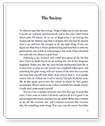Essay Instructions: We will pay $300.00 for the completion of this order.
Dear students,
In this project, you are supposed to be a financial manager to apply the financial knowledge obtained from the course to estimate the cost of debt, cost of preferred stock, cost of common equity, capital structure, and the weighted average cost of capital (WACC) for a publicly-traded company of your choice. Then you are required to use the WACC as the discount rate to perform capital budgeting analysis of a project that the firm is considering.
(1) Read the Instructions for the Final Project carefully. Please let me know if you have any questions.
(2) You should inform the instructor of the company you choose before your formally start the project. Students should analyze different firms. If several students happen to select the same company, the first student who informs the instructor has the priority, so other students have to change their company selections.(Therefore, do not do a company that is too common)
(3) Financial data and industry ratios are available in the UHV online library.
(4) Your project should be well-organized and typed in a WORD file (Office 2003 version). Attach the necessary tables and/or worksheets with your report. The style and organization of the project accounts for 10 points. List the references that you cited or used in your project. The Final Project Grade Sheet may help you understand the contribution of each part of the project to your overall grade.
++++++++++++++++++++++++++++++++++++++++++++++++++++++++++
INSTRUCTIONS TO THE PROJECTS:
Cost of Capital, Capital Structure,
and Capital Budgeting Analysis
1. Purpose of the project:
In this project, you are supposed to be a financial manager working for a big corporation and you have to apply the knowledge obtained from the financial management (FIN6352) course to determine the cost of debt, cost of preferred stock, cost of common equity, capital structure, and the weighted average cost of capital (WACC) for a publicly-traded company of your choice. You will use the WACC as the discount rate to conduct capital budgeting analysis for a project that the firm is considering and then decide whether it should be accepted or not.
2. Outline for the project:
(1) Executive Summary (10 points)
- Summarize the results and analysis of the report.
(2) Financial Ratio Analysis (40 points)
- Perform trend analysis of the key financial ratios (i.e., liquidity ratios, asset management ratios, debt management ratios, profitability ratios, market value ratios) of the company.
- Perform industry (or benchmark companies) comparison analysis of the key financial ratios of the company.
- Based on the financial ratio analysis results, evaluate the financial performance of the company.
(3) Estimate Capital Structure (25 points)
- Estimate the firm¡¯s weights of debt, preferred stock, and common stock using the firm¡¯s balance sheet (book value).
- Estimate the firm¡¯s weights of debt, preferred stock, and common stock using the market value of each capital component.
(4) Compute Weighted Average Cost of Capital (WACC) (35 points)
- Estimate the firm¡¯s before-tax and after-tax component cost of debt;
- Estimate the firm¡¯s component cost of preferred stock;
- Use three approaches (CAPM, DCF, bond-yield-plus-risk-premium) to estimate the component cost of common equity of the firm.
- Calculate the firm¡¯s weighted average cost of capital (WACC) using market-based capital weights.
(5) Cash Flow Estimation (40 points)
- We assume that the company you selected is considering a new project. The project has 8 years¡¯ life. This project requires initial investment of $120 million to purchase land, construct building, and purchase equipment, and $8 million for shipping & installation fee. The fixed assets fall in the 7-year MACRS class. The salvage value of fixed assets is $30 million. The number of units of the new product expected to be sold in the first year is 800,000 and the expected annual growth rate is 8%. The sales price is $200 per unit and the variable cost is $150 per unit in the first year, but they should be adjusted accordingly based on the estimated annualized inflation rate of 3%. The required net operating working capital (NOWC) is 12% of sales. The company is in the 40% tax bracket. The project is assumed to have the same risk as the corporation, so you should use the WACC you obtained from prior steps as the discount rate.
- Compute the depreciation basis and annual depreciation of the new project. (Please refer to table 12-3 MACRS allowances)
- Estimate annual cash flows for the 8 years.
- Draw a time line of the cash flows.
(6) Capital Budgeting Analysis (40 points)
- Using the WACC you obtained for the publicly-traded company as discount rate, apply capital budgeting analysis techniques (NPV, IRR, MIRR, PI, Payback, Discounted Payback) to analyze the new project.
- Perform a sensitivity analysis for the effects of key variables (e.g., sales growth rate, cost of capital, unit costs, fixed costs, sales price) on the estimated NPV or IRR in order to demonstrate the sensitivity of the model.
- Discuss whether the project should be taken and summarize your report.
3. Other information regarding the project:
(1) Avoid firms in the financial sector. Their financial statements are not compatible with the type of model we study in this class. Generally, financial firms have 4-digit SIC codes 6000s.
(2) You will inform the instructor of the company you choose. Students have to choose different companies. If several students want to use the same company, the first student to inform the instructor will have priority; the others will have to pick another company.
(3) Your project should be well-organized and typed in a Word document and attach the necessary Excel worksheets with your report. The style and organization of the project is important.
++++++++++++++++++++++++++++++++++++++++++++++++++++++++++++
Financial Data and Industry Ratios Resources
(1) In the database D&B Key Business Ratios, you can find some key industry & business ratios. Other books, reference & print resources include 1) Almanac of Business and Industrial Financial Ratios 2) Industry Norms and Key Business Ratios 3) Robert Morris Associates (RMA) Annual Statement Studies.
(2) In the database Mergent Online, you can find financial data and information for most U.S. publicly-traded firms.
+++++++++++++++++++++++++++++++++++++++++++++++++++++++++++++
FIN6352-Financial Management
Individual Term Project Grade Sheet
Category
Possible Points
Actual Points
Executive Summary
10
Final Ratio Analysis
40
Estimate Capital Structure
25
Compute WACC
35
Cash Flow Estimation
40
Capital Budgeting Analysis
40
Style and Organization
10
Total
200
++++++++++++++++++++++++++++++++++++++++++++++++++++++++++++
PROJECT RUBIC:
Perform capital budgeting analysis for a publicly traded company
1. Estimate the component cost of capital: Student applies capital asset pricing model to estimate cost of equity component. Can correctly estimate cost of debt and cost of equity. Students use various methods for each component cost.
2. Obtain the capital structure and calculate the weighted average cost of capital: Student must correctly estimates weights on capital components using book values and market values. Student correctly estimates cost of capital.Student researches financial reports and finds the target capital structure. Student presents a comparison against other firms in the industry.
3. Calculate net cash flows for an expansion project:Student correctly estimates Operating Cash Flows (OCF), correctly uses the adjustments to Net Operating Working Capital (NOWC) and calculates the Salvage Cash Flows. Student uses models that consider inflation rates, multiple depreciation schedules and different salvage values.
4. Evaluate an expansion project: Student correctly calculates NPV and IRR in order to evaluate the project. Student documents his/her conclusion. Student applies other tools to evaluate the project. Student includes results for scenario analysis and uses sensitivity analysis for the main input variables.


